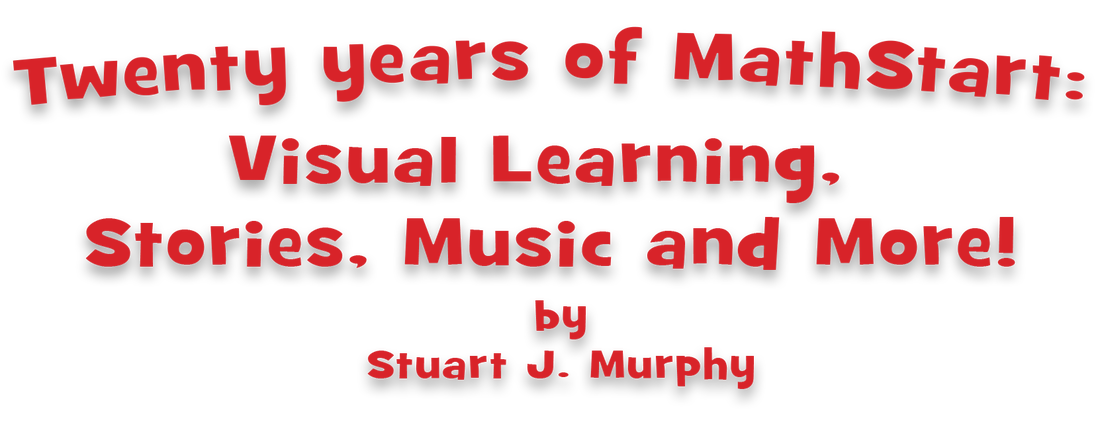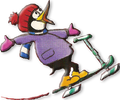|
What an idea! Writing stories about math for kids!
I have spent my entire career working in educational publishing, first as a designer, then as an art director and later as co-founder of Ligature, Inc., a Chicago-based company dedicated to the development of high-quality educational products for schools. Ligature innovated a new and different approach to creating these products, incorporating a visual / verbal collaboration from the very start of the development process. We recognized that children are visual learners and that they are often better able to understand new ideas from visual displays. We felt that educational programs designed to leverage this learning style would be more effective: products presenting the content through both visual models and text. Ligature developed a number of successful programs based on this concept. VISUAL LEARNING During this period in the 1980s, I became an advocate for visual learning and the skills and strategies associated with it. Visual learning is about acquiring and communicating information through illustrations, photos, diagrams, graphs, symbols, icons, and other visual representations. It is about making sense of complex data using visual models. Visual learning skills include:
I became convinced that visual learning strategies, as a kind of international "language," lead to representations that everyone can understand, regardless of their background. Its practice could be a powerful way of reaching all students. CONTEXTUAL LEARNING In 1992, I was hired to be the Visual Learning Specialist on the authorship team for a new high school mathematics program—a new role I invented in my quest to have visual representation included from the inception of the development of educational products. The other authors wrote. I sketched. The combination was a visual / verbal presentation of content that supported the way students learn. They could the see the math! While working on this program, I had the opportunity to visit classrooms and try out my ideas with the ultimate users: the kids. I learned that elementary and secondary school students become much more engaged in math when it is delivered within the context of something that interests them—a setting that shows the math in use. They want stories about math! This was an exciting revelation: If students can see how the math works and understand how it might be used, they are more interested in doing it. A NEW CONCEPT I kept thinking that if this worked for older students, it could be a really powerful idea for young children. I like to write and have always had an extensive collection of children’s books. I majored in illustration at the Rhode Island School of Design (RISD)—the department was the perfect place to learn about the creation of children’s books. Some of the world’s most renowned authors and illustrators of children’s books studied at RISD. It felt like something that was in my blood. I decided to try out the idea and began to develop storyboards for three math books. I selected math skills that I knew were important for young children to learn. I sketched out visuals that showed how the math worked. I created settings that I knew would interest kids. The pictures, words and math came together to tell the story. To be sure that my ideas about what interested kids were correct, I visited the children’s section at bookstores to see what books and magazines they selected. I also talked with kids whenever I had a chance and even asked them to empty their backpacks to show me what was inside. It wasn’t long before I had an impressive list of subjects from which to draw! At the same time, I talked with teachers about what math topics gave their students the most trouble. I set out to create books that would help teachers explain difficult math concepts and help kids more easily understand them. Again, a long list developed in a very short time. Using the storyboards for reference, I wrote stories, made diagrams of math concepts, and created rough sketches for illustrations. I was able to construct dummies—models of the books—to show what I was envisioning. Through some publishing contacts, I was able to present the three dummies to a number of publishers, including HarperCollins Children’s Books. The Creative Director, a designer and visual communicator herself, was immediately intrigued. That led to a series of meetings and presentations until—finally—I was offered a contract for my first three children’s books. I was thrilled! THE BIRTH OF A SERIES
I was eager to have HarperCollins consider even more books in the future. Armed with long lists of interesting contexts and challenging math topics, I imagined a series of perhaps a dozen or more storybooks that would help children be more successful in math. Those discussions led to the division of the series into three levels:
We also had many long discussions on what to name the series. MathStart, we felt, embodied the purpose of the program: helping young children get a good start in understanding math and building their skills. A math start! It wasn’t long before my contract was extended to 12 books. I consulted my lists and began working away on the next titles in the series. At lunch and dinner, my wife Nancy would listen to my story ideas and make suggestions for titles and better endings. I engaged a reviewer with a strong math background to critique everything I wrote to make sure the math was correct. My editors at HarperCollins worked closely with me developing the storylines. When kids ask me about the hardest part of writing a MathStart story, I tell them it is merging math and story. The math must be correct and fully represent the topic while not overpowering the story. The story must be cohesive and interesting, yet still allow room for the math. Soon, the tally for MathStart books had climbed to 24 and I was working on six new books a year. At every moment, I had one or two manuscripts near completion, a few more midstream and others incubating. I looked to the lives of my own children, Randy and Kristin, and to the activities of my grandchildren, Jack and Maddie, for inspiration. When the tally doubled to 48, I decided to name the book Jack the Builder (Level 1 / counting on) for my grandson and Mighty Maddie (Level 1 / comparing weights) for my granddaughter. Then along came Camille, just in time for one of my later books, Rodeo Time (Level 3 / reading a schedule) to be dedicated to her. REVIEWS, CONFERENCES & FAMILY MATH NIGHTS
Slowly but surely, people began to hear about the series. Reviews began to appear in trade and educational publications and I did a number of tours to bookstores around the country. I was also invited to write articles for magazines and newspapers and to present at conferences of the National Council of Teachers of Mathematics (NCTM) and the International Reading Association (IRA). Later I would add the National Council of Teachers of English (NCTE), the National Association for the Education of Young Children (NAEYC), the National Council of Supervisors of Mathematics (NCSM), and the National Head Start Association (NHSA) to the roster. Perhaps most fun of all, I was invited to visit schools. I have visited over 500 schools in 47 states and five foreign countries: China, India, Italy, England and Qatar. Family Math Nights are always big draws and amazing events. One school I visited decorated every classroom door in the entire building to match a different MathStart book! What a thrill it was walk down hallways that looked like a theme park for my work. At another school, students invented games based on the math concepts in my books. A third school produced a show around my stories. The Kindergartners danced to the The Bug Dance (Level 1 / directions), while First Graders shuffled through patterns from Beep Beep, Vroom, Vroom! (Level 1 / patterns) and Second Graders sang a song about the characters in Coyotes All Around (Level 2 / rounding). Bravo! School visits and the conferences always include book signings. At one NCTM conference, I signed over 1,500 hundred books! I always feel so honored when teachers, parents and especially kids want my signature in their books. THE MAIN STREET KIDS' CLUB
In 2007, Janet Ginsburg, who has long worked with me supporting the series and developing various projects, came up with an idea to develop a musical based on the MathStart books. She met with Rives Collins, Chair of the Department of Theater at Northwestern University, who suggested that Scott Ferguson, a talented Chicago-based director / playwright / actor be brought in to develop the adaptation. Scott had also adapted Schoolhouse Rock Live!, the popular theatrical production based on the beloved television animated shorts. Scott teamed up with Jeff award-winner Michael Mahler to compose the music. Their workshop class at Northwestern was quickly oversubscribed! I came in to talk about visual learning and provide some background on the series. The result? The Main Street Kids’ Club: A MathStart Musical! The show—45 minutes of toe-tapping math-a-licious fun that weaves together six of my stories—has been performed in children’s theaters and schools across the country. Sometime assemblies are held beforehand so members of the cast prepare students for the experience. When the Maple Street School in Rockville, Connecticut, my Kindergarten-through-Grade-3 alma mater, planned such an event, someone asked, “Will Stuie (my childhood nickname) be there?” You bet! My wife Nancy and I had such a good time! All sorts of fabulous activities are planned for the Boston Premiere of The Main Street Kids’ Club (MSKC) this spring at the Watertown Children’s Theatre, including a panel discussion where Scott and I will talk about the development of the production. There will also be performances at the annual meetings NCSM and NCTM, which, serendipitously, are both being held in Boston this year—which just happens to be where I live. "Math Skills = Life Skills" is the MSKC motto. They are Lots-of-Fun skills, too! MATHSTART IN CHINA
In 2009, a contract was secured to publish the entire series, now 63 books, in Chinese. The series was already successful in Korea (published in Korean). In 2011, I was invited to China for two weeks of presentations to academic groups and students in seven cities. We started in Chengdo, then traveled to Beijing for the official inauguration of the program that included a presentation to a large audience of teachers, parents, and members of the press, as well an appearance on an educational television program. The last five days were whistle-stop visits. We would take a late afternoon fast train, arrive in time for dinner, check out of the hotel early in the morning, present at a school, then board a train for the next location. MathStart on the move! Early in the trip, I had a chance to ask two questions that had been on my mind. The first was about the role the publisher expected my books to play in China. "With China leading the world in math scores and the United States lagging behind in sixteenth or seventeenth place, why would the Chinese be interested in stories about math by an American author?" The answer was very revealing. The editors felt that although Chinese students had learned to test well in math, they hadn’t learned to apply those skills to real life situations. They believed it would be a great benefit to students if math instruction that clearly produced good test results were augmented with stories that showed how math is actually used. The response to my second question was equally revealing. I pointed out that my stories were about specifically American activities such as going to a carnival, taking care of a pet, shopping in a mall and playing sports. "Would children in China be able to relate to these settings?" The answer: Since the students knew I was an American author, they would expect me to write about American themes and not Chinese themes. The editors also thought the stories would help students learn more about the everyday lives of kids in America. STEM & STEAM
During this same period, the STEM movement (Science, Technology, Engineering and Mathematics) became a national priority, framed as critical to ensuring US global competitiveness in the 21st century. In 2006, the US National Academies, concerned about the declining state of STEM education, made suggestions for improving K-12 science and math programs and strengthening the skills of STEM teachers with the goal of boosting the number of students pursuing STEM-related college degrees. RISD, where I studied Art and served as a trustee for 19 years, has been a leader in advancing a related initiative known as STEAM (just add the A for Art). The practice of art and design foster creativity that, when combined with science and technology, can lead to significant innovation. STEAM, too, has now become a national movement, one that speaks to the importance of the arts in securing our economy. MathStart was developed before STEM or STEAM, but fits right into the movement, combining the arts of illustration and storytelling with mathematical modeling. For ten years (2002-2012), I served on the Arts in Education (AIE) Advisory Council of the Harvard Graduate School of Education, which was both an honor and pleasure. The AIE program is dedicated to the inclusion of the arts in every curriculum area. Graduate students from a variety of fields subscribe to AIE courses to learn how to bring an arts-driven approach to their primary areas of study. This is STEAM in action! THE I SEE I LEARN SERIES
Strolling the trade show aisles of a NAEYC conference (National Association of the Education of Young Children), Janet Ginsburg realized that taken separately, the 21 Level 1 MathStart books would rank among the largest—if not the largest—Pre-K math series on the market. I began to think more deeply about early childhood education and the unique needs of the fast-growing preschool market. Young children may be emergent readers, but they are accomplished visual learners who routinely seek out information and derive meaning from a wide variety of visual stimuli. At the same time, research was confirming something long known by teachers: social and emotional skills at the Pre-K and Kindergarten levels are excellent predictors of school success. A young child with good self control who understands how to work and play with others is easier to teach. Good begets better, but bad can lead to worse, so it is critical to master these skills early. I began delving into the guidelines and standards being written for early childhood learning and envisioning another series of books: stories—again presented visually and verbally—but focused on social, emotional, health and safety, and cognitive skills for preschoolers. I developed manuscripts with sketches, created dummy books and together with Janet worked on a plan to partner with a publisher for the series. Boston-based Charlesbridge Publishing became that partner and the series--I See I Learn—is now 16 books strong and, like MathStart, has been published in several foreign languages, including Spanish, Chinese and Arabic. I See I Learn also gave me a chance to feature my youngest granddaughter, Camille, in a book—just like her sister Maddie and cousin Jack had been featured in MathStart stories. Lucky Camille now “stars” in two books: Camille’s Team (cooperation) and Great Choice, Camille! (making decisions). I SEE I LEARN AT SCHOOL
Throughout the development of both series, I continued my work in educational publishing. I am on the authorship team of a number of mathematics programs published by Pearson Education, including the popular K-6 enVisionMATH program, an all-digital Middle Grades mathematics program called digits and a High School mathematics program. Straddling the worlds of educational and trade publishing made me dream of the possibility of having a series of books available in both markets, something that rarely, if ever, happens. The dream came true when Pearson Education agreed to develop I See I Learn at School adding a wide variety of educational support materials to complement the books: an Overview and Implementation Guide, 16 Teacher Guides, classroom posters, activities for school and home and digital animations and games. MATHSTART AT TWENTY
What a journey it has been! It was actually more than 20 years ago when I had the first glimmer of an idea for a series of books that would teach mathematical concepts to children using a simple stories and visual learning strategies. But it was 1995 when I held the very first MathStart book in my hands: The Best Bug Parade (comparing sizes). To this day it is my favorite because it was the first. I am truly honored to have had this experience and to have enjoyed the support of so many colleagues, educators, students, friends and family members on this incredible adventure. |
Stuart J. Murphy's MathStart




